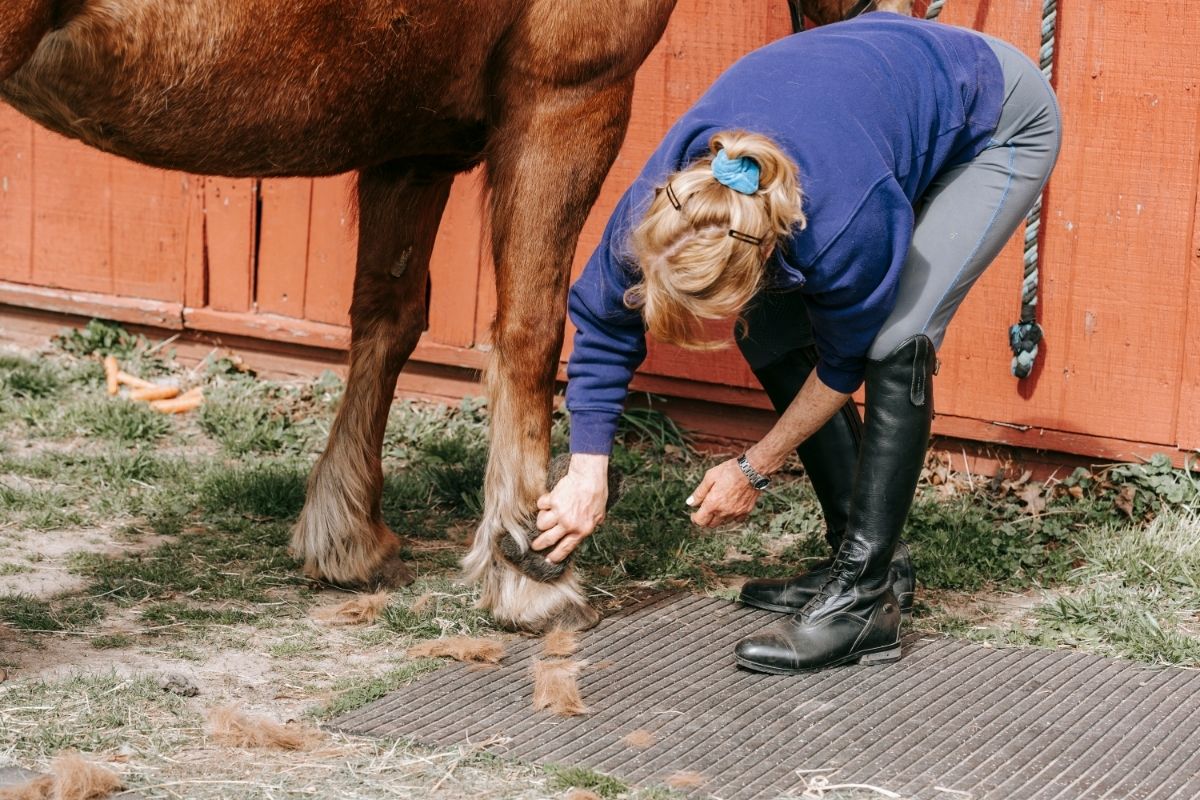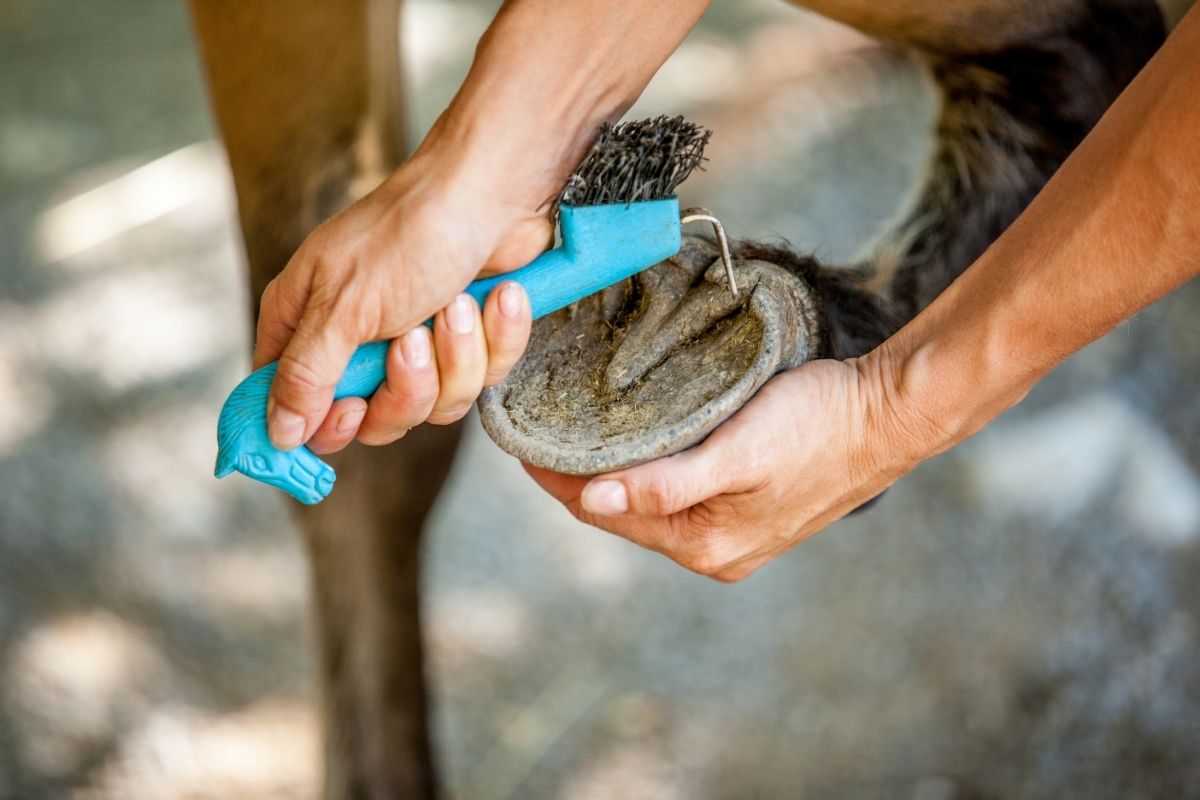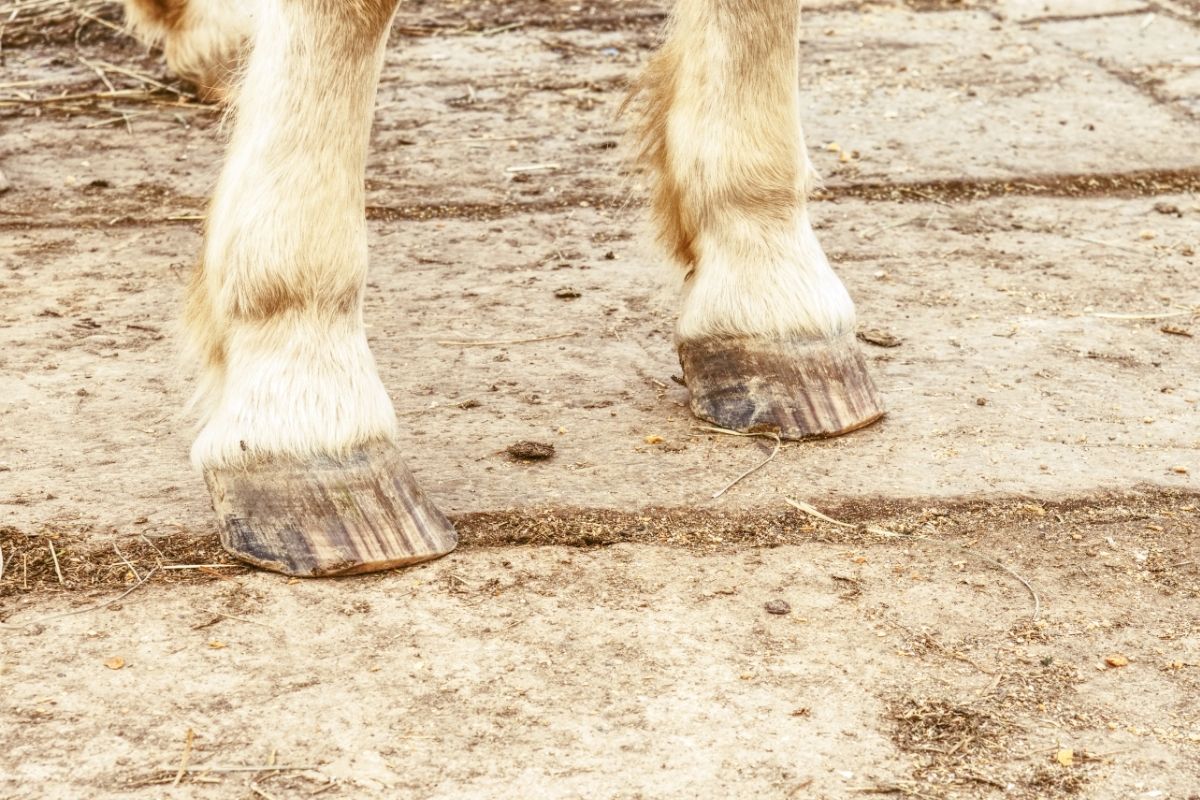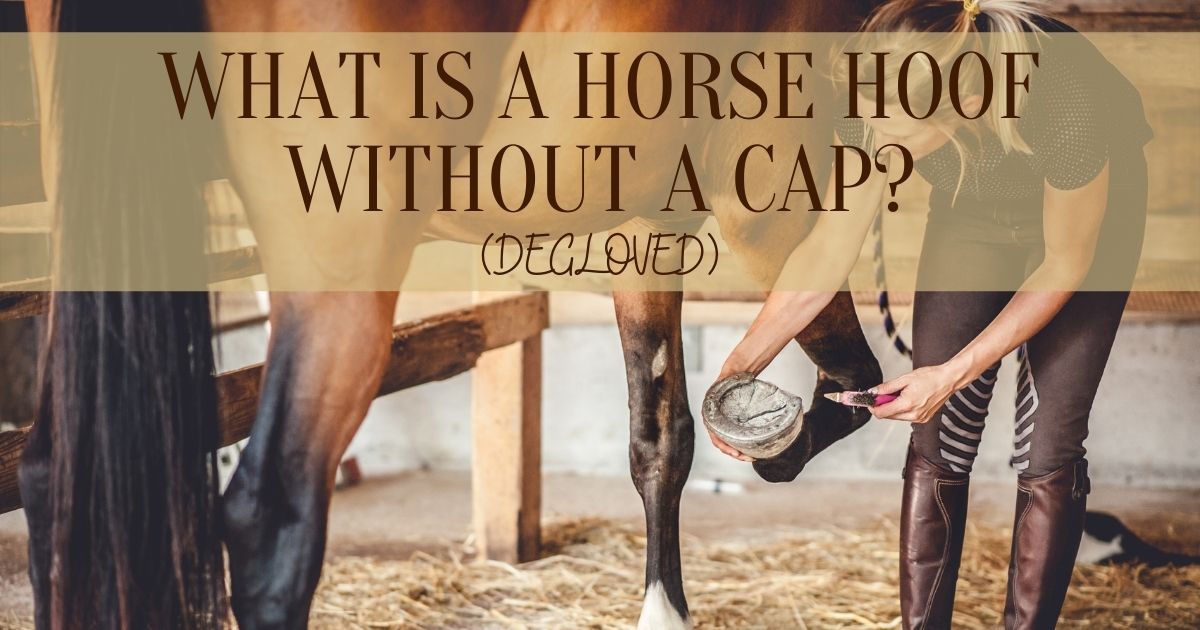What is a Degloved Horse Foot?
A horse hoof without a cap is where the hoof separates from the rest of the leg. In most instances, it is the result of an injury.
The hoof will typically be attached to the leg by only a small amount of tissue, and it may be possible to see the bone underneath. The hoof may even detach from the leg completely in some cases.
A degloved horse can be very painful for the animal and have serious complications if not treated properly. If you suspect that your horse could have a degloved foot, it is important to contact your veterinarian immediately.

What Causes Horse Degloving?
Horse hoof falling off is a serious injury when the skin peels away from the underlying tissue.
There are many potential causes of this condition, and it is crucial to be aware of all of them to prevent it from happening. Here are ten possible reasons for horse degloving:
Trauma
One of the causes of horse degloving is trauma. This can occur from a fall or any other type of accident.
Infection
If the horse has an infection in the skin, it can cause the skin to separate from the underlying tissue. You can often see this in horses with bites from another animal or having a wound that became infected.
Allergy
An allergy can also cause the skin to separate from the underlying tissue. You may notice this in horses allergic to certain materials, such as those used in saddles or blankets.
Disease
Some diseases can cause horse hoof caps. One example is Cushing’s disease, which is a condition that affects the endocrine system.
Chemical Burns
If the horse comes into contact with a chemical that burns the skin, it can cause degloving. Some common culprits include acids and alkalis.
Electrocution
Electrocution can also cause horse golden slippers. This often happens when horses touch downed power lines or other electrical equipment.
Sunburn
Sunburn can cause the skin to become dry and cracked, making it more susceptible to injury.
Frostbite
Frostbite can occur in horses if exposed to extreme cold temperatures for an extended period. This might destroy the skin and lead to trypophobia dehooved horse.
Poor Circulation
If the horse has poor circulation, it can cause the skin to become thin and fragile. This makes it more susceptible to injury and degloving.
Excessive Weight
Excessive weight can also put pressure on the skin and underlying tissue, which can cause horse degloving. You can see this in ponies and draft horses that are overweight.
Horse degloving is a serious condition that can have many different causes. It is important to be aware of all of the potential causes so that you can take measures to stop them from happening to your horse.
If you think your horse may be at risk for this condition, talk to your veterinarian about the next steps to help protect them.
How to Identify a Dehooved Horse
Wondering how you can identify a degloved horse foot? It’s not as challenging as you might think. Here are some nuggets to help you out:
- Look for horses with bald patches on their heads or necks.
- Check for horses missing large chunks of hair from their bodies. Again, this is often a sign of degloving.
- Pay attention to how the horse is moving. If it looks like it’s in pain, there’s a good chance that it has been dehooved.
- A dehooved horse will have no hooves. This is the most obvious sign.
- Look for a horse with missing skin on its legs. The skin may be completely missing, or it may be hanging off in strips.
- Check exposed muscles, tendons, and bones. Without skin to protect them, these structures will be visible.
- Identify open wounds. Degloving injuries often result in open wounds.
- Look for swelling and bruising. Degloved injuries are often accompanied by swelling and bruising.
- Signs of shock. Horses with degloving injuries may go into shock, which can be deadly. Shock may cause the horse to collapse, have a rapid heartbeat, or have difficulty breathing.
If you’re still yet sure whether or not a horse has been dehooved, don’t hesitate to contact your local veterinarian for more advice. Dehooving can be a serious issue, and it’s important to get help if you think your horse might be affected. Thanks for reading!
Treating Degloved Horse Feet
If your horse has a degloved foot, it is important to seek veterinary care as soon as possible. Degloving injuries are excruciating and can result in serious infections.
The first step in treating a dehoofed horse is to clean the wound. This involves removing any dead tissue and bacteria from the injury. Your vet will likely use a scalpel or other sharp instrument to do this.
Once the wound is clean, your vet will need to determine whether or not it is necessary to amputate the foot. The injury is so severe that amputation is the only option in some cases.
However, if the degloved area is small and there is healthy tissue around it, your vet may be able to repair the foot using stitches or a bandage.
If the injury is severe, your horse will likely need to stay at the vet’s office for a few days for a check-up and treatment. It will likely require antibiotics and pain medication.
The prognosis for horses with degloved feet depends on the severity of the injury. Some horses are able to return to normal activity after treatment, while others may require lifelong care.
The Importance of Healthy Horse Hooves
There are many reasons why you need to keep horse hooves healthy, but here are ten of the most important:
1. A horse’s ability to walk and run depends on its hooves being in good condition.
2. If a horse’s hooves are not healthy, they can develop lameness or other health problems.
3. Poorly-conditioned hooves can make it difficult for horses to move around and cause them pain.
4. To stay healthy, horses need exercise, which is especially important for their feet and legs.
5. Horses that aren’t allowed to roam free will often have problems with their hooves due to lack of exercise.
6. If hooves are not trimmed and cared for properly, they can become overgrown and cracked, leading to infection.
7. Hooves that are not kept clean can also develop infections and are potentially dangerous for horses.
8. Horse hooves need to be regularly conditioned to stay healthy and prevent cracks or other damage.
9. Proper hoof care is essential for horses’ overall health and should be done regularly.
10. Healthy hooves are essential for the safety of both horses and riders, so it’s crucial to take care of them.
As you can see, there are numerous reasons why healthy horse hooves are important. If you have a horse, be sure to take care of their hooves and make sure they stay in good condition. Your horse will thank you for it!
Healthy horse hooves are important for the animal’s health and well-being and the rider’s safety.

Horse Hoof Anatomy
If you’re a horse owner, it’s important to know the basics of horse hoof anatomy. After all, your horse’s feet are its foundation! So if you’re curious about what’s going on under a horse hoof, keep reading.
The horse hoof comprises several different parts, each with its specific function.
The Hoof Wall
The hoof wall is the outermost layer of the hoof and comprises keratin, the same protein that makes up hair and nails. The hoof wall protects the foot’s soft tissues from damage and helps to keep out moisture and dirt.
The Frog
The frog is a V-shaped structure located at the back of the hoof. It acts as a shock absorber, helps to circulate blood and lymph fluid through the foot, and provides traction when the horse is walking or running.
Common problems with the frog include thrush (a bacterial infection) and abscesses.
Preventing these problems starts with keeping the feet clean and dry. If you notice any changes in your horse’s frog, such as excessive discharge or swelling, be sure to contact your veterinarian.
The Coronary Band
The coronary band is a ring of tissue located at the top of the hoof where it meets the leg. This area is critical because it produces new hoof cells and contains the hoof’s blood vessels and nerves.
If the coronary band is damaged, it can affect the health of the hoof. Laminitis coronary band is a condition that can easily affect the coronary band.
This is a condition in which the sensitive tissues underlying the hoof wall deteriorate due to a lack of blood flow to the feet).
The Heel
Located at the back of the foot, the heel is responsible for bearing weight when the horse is standing. It’s also important for providing traction when the horse walks or runs.
The heel can experience bruising, cracks, and chips. Heel pain is also a common problem in horses. The best way to prevent heel problems is to have your farrier regularly trim and balance your horse’s feet.
The Sole
The sole is the bottom of the hoof, and it protects the sensitive tissues inside the foot from injury. The frog also helps to support the horse’s weight when it’s standing.
The sole may experience abscesses and thrush. It’s important to keep the area clean and dry to prevent these problems. If you notice any changes in your horseshoe, such as excessive discharge or swelling, contact your veterinarian.
Now that you know more about horse hoof anatomy, you can now understand why it is important to take care of your horse’s feet.
By keeping the hoof wall clean and dry, maintaining the frog, and regularly trimming and balancing the heels, you can help prevent common problems from occurring. So be sure to put your horse’s hooves at the top of your list of priorities.
If you’re a horse owner, it’s important to know the basics of horse hoof anatomy. After all, your horse’s feet are its foundation!
What Is The Difference Between Blistering and Degloving?
When discussing injuries in horses, blistering and degloved horse hoof are two words that people often use. But what is the difference between them?
Blistering is a condition that results when burning occurs on your horse’s skin. The top layer of skin peels away from the underlying tissue, forming a blister. On the other hand, Degloving is a type of injury that occurs when the skin and underlying tissue get pulled off the bone.
Degloving can be a life-threatening injury, as it can expose the horse’s bones and blood vessels to the outside environment. Blistering, while not as serious, can still be quite painful for the horse and can take weeks or even months to heal.
So, what’s the difference between blistering and degloving? Blistering is a condition that results from a burn, while degloving is an injury that occurs when the skin and underlying pulling away of the tissue from the bone.
Degloving is a more serious injury than blistering, as it can expose the horse’s bones and blood vessels to the outside environment. Blistering can still be quite painful for the horse and can take weeks or months to heal.
With this in mind, it’s important to be able to distinguish between these two injuries in order to provide the best care for your horse.
The most common cause of blistering is contact with a hot object, such as a branding iron. Blistering can also occur from prolonged exposure to the sun or other heat sources, such as a heated water bucket.
The symptoms of blistering depend on the severity of the injury. A mild case may only result in redness and swelling of the skin, while a more severe case can cause the top layer of skin to peel away from the underlying tissue, forming a blister.
Treating blistering depends on the severity of the injury. For a mild case, you may only need to apply a topical ointment to help soothe the skin. More severe cases may require the use of antibiotics or even surgery to remove the damaged tissue.
There are a few things you can do to help prevent your horse from developing blisters. First, be sure to provide plenty of shade and fresh water for your horse when hot outside.
If you’re using a heated water bucket, be sure to check the temperature of the water before allowing your horse to drink. Finally, avoid using any type of heat on your horse’s skin, such as a branding iron.
Trypophobia dehooved horse injuries can happen due to entanglement with barbed wire or other sharp objects. It can also occur from a fall, where the horse’s weight pulls the skin away from the underlying tissue.
The symptoms of degloving depend on the severity of the injury. A mild case may only result in redness and swelling of the skin, while a more severe case can cause the pulling away of the skin and underlying tissue from the one, exposing it to the outside environment.
You can treat degloving depending on the severity of the injury. For a mild case, you may only need to apply a topical ointment to help soothe the skin. More severe cases may require surgery to reattach the skin and underlying tissue to the bone. In some cases, the limb may need to be amputated.
How Can Equine Degloving Be Prevented?
There are a few ways that you can prevent degloving injuries in horses. Let’s have a look at them:
1. Make sure that your horse is wearing the correct type and size of horseshoes. If the horseshoe is too small, it will rub against the hoof and cause friction. This can lead to degloving injuries. Likewise, if the horseshoe does not fit properly, it can come off or move around on the hoof, which can also cause degloving injuries.
2. Trim your horse hoofs and keep them in good condition. If you don’t trim hoof capsules properly, they can crack or break, leading to degloving injuries.
Likewise, if the hooves are not in good condition, they will be more susceptible to injury. Cracked or broken hooves can also be a source of infection, leading to degloving injuries.
3. Make sure that your horse is not overweight. Excess weight can stress the hooves and legs, leading to degloving injuries.

How Can I Help my Horse With the Healing Process
Once a degloving injury has occurred, there are a few things that you can do to help your horse heal properly. It is important to keep the wound clean and free of infection. You can do this by using a saline solution or an antiseptic spray on the wound twice a day.
It would be best to clean the wound every time your horse urinates or defecates. If the injury is severe, you may need a vet to treat it. The vet will likely prescribe antibiotics or other medications to help heal.
